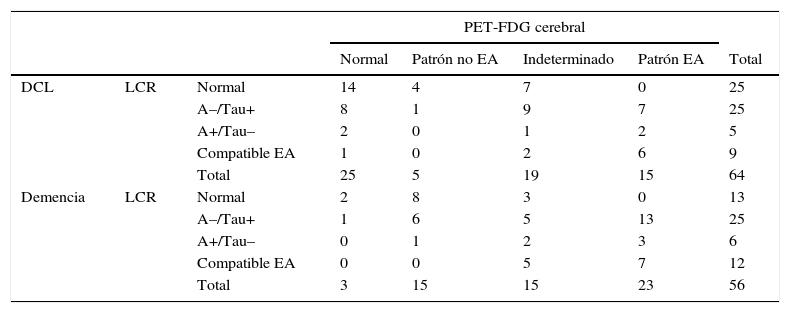El hipometabolismo cortical posterior por PET con 18F-FDG (PET-FDG) y la alteración de los niveles del péptido Aß1-42 y las proteínas Tau total (tTau) y Tau fosforilada (pTau) en líquido cefalorraquídeo (LCR) son biomarcadores establecidos para el diagnóstico de la enfermedad de Alzheimer (EA). Evaluamos la concordancia y la relación entre los resultados de la PET-FDG y los biomarcadores en LCR en pacientes sintomáticos con sospecha de EA.
Material y métodosRevisión retrospectiva de 120 pacientes con deterioro cognitivo admitidos en la Unidad de Neurología Cognitiva a los que se les ha realizado punción lumbar para la determinación de biomarcadores en LCR y una PET-FDG cerebral. Para el análisis de concordancia (coeficiente Kappa), el resultado de la PET-FDG y del conjunto de los biomarcadores-LCR se clasificó en cada paciente como normal, no-concluyente, o compatible-EA. Se efectuó además una regresión logística incluyendo las variables cuantitativas Aß1-42, tTau y pTau como predictores y la PET-FDG como variable dependiente.
ResultadosEl coeficiente Kappa ponderado entre PET-FDG y biomarcadores-LCR fue de 0,46 (IC 95%: 0,35-0,57). En el análisis por regresión logística, la Aß1-42 y la tTau fueron en conjunto capaces de discriminar un resultado PET metabólicamente sugestivo de EA de uno no sugestivo de EA, con una sensibilidad del 91% y una especificidad del 93% aplicando la recta de corte Aß1-42=44+1,3×tTau.
ConclusionesLa concordancia entre la PET-FDG cerebral y los biomarcadores-LCR es moderada, lo cual indica su valor complementario en el diagnóstico de EA. Los niveles de Aß1-42 y tTau en LCR son buenos predictores del estatus metabólico característico de EA por PET-FDG cerebral.
Cortical posterior hypometabolism on PET imaging with 18F-FDG (FDG-PET), and altered levels of Aß1-42 peptide, total Tau (tTau) and phosphorylated Tau (pTau) proteins in cerebrospinal fluid (CSF) are established diagnostic biomarkers in Alzheimer's disease (AD). An evaluation has been made of the concordance and relationship between the results of FDG-PET and CSF biomarkers in symptomatic patients with suspected AD.
Material and methodsA retrospective review was carried out on 120 patients with cognitive impairment referred to our Cognitive Neurology Unit, and who were evaluated by brain FDG-PET and a lumbar puncture for CSF biomarkers. In order to calculate their Kappa coefficient of concordance, the result of the FDG-PET and the set of the three CSF biomarkers in each patient was classified as normal, inconclusive, or AD-compatible. The relationship between the results of both methods was further assessed using logistic regression analysis, including the Aß1-42, tTau and pTau levels as quantitative predictors, and the FDG-PET result as the dependent variable.
ResultsThe weighted Kappa coefficient between FDG-PET and CSF biomarkers was 0.46 (95% CI: 0.35-0.57). Logistic regression analysis showed that the Aß1-42 and tTau values together were capable of discriminating an FDG-PET result metabolically suggestive of AD from one non-suggestive of AD, with a 91% sensitivity and 93% specificity at the cut-off line Aß1-42=44+1.3×tTau.
ConclusionsThe level of concordance between FDG-PET and CSF biomarkers was moderate, indicating their complementary value in diagnosing AD. The Aß1-42 and tTau levels in CSF help to predict the patient FDG-PET cortical metabolic status.
Artículo
Comprando el artículo el PDF del mismo podrá ser descargado
Precio 19,34 €
Comprar ahora









